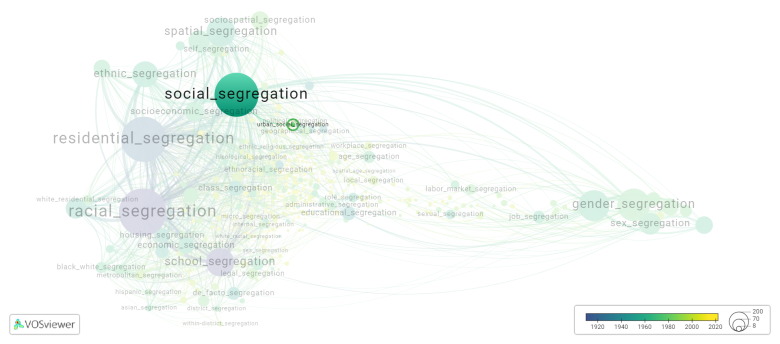Urban social segregation: Difference between revisions
(Creating page) |
(Creating page) |
||
| Line 16: | Line 16: | ||
[[File:urban_social_segregation.png|780x780px]] | [[File:urban_social_segregation.png|780x780px]] | ||
Visualization based on the [[How_to_cite_Segregation_Wiki| research]] | |||
For the complete network of associated segregation forms, see: | For the complete network of associated segregation forms, see: | ||
year of publication https://tinyurl.com/2235lkhw | * First year of publication https://tinyurl.com/2235lkhw | ||
Louvain clusters https://tinyurl.com/2d8wg5n3 | * Louvain clusters https://tinyurl.com/2d8wg5n3 | ||
* Betweenness centrality https://tinyurl.com/223udk5r | |||
* Disciplines where segregation forms first appeared https://tinyurl.com/244d8unz | |||
==References== | ==References== | ||
==Notes== | ==Notes== | ||
Revision as of 13:41, 3 October 2024
Date and country of first publication[1]
1986
France
Definition
Urban social segregation refers to the division and separation of different social or economic groups within urban areas. This separation can manifest in various ways, such as the clustering of wealthy residents in exclusive neighborhoods, the concentration of low-income communities in certain areas, or the exclusion of certain groups from accessing resources and opportunities in the city.
Social segregation can have serious consequences for cities, including limited access to quality education, healthcare, and employment opportunities for marginalized groups, as well as increased social tensions and inequalities. It can also lead to the creation of "ghettos" or "enclaves" within a city, where certain groups become isolated and marginalized from the rest of society.
Efforts to address urban social segregation often involve policies and initiatives aimed at promoting mixed-income housing, improving access to public services in marginalized communities, and fostering social inclusion and cohesion across different social groups in the city. By promoting more inclusive and equitable urban environments, cities can work towards reducing social segregation and building more vibrant and cohesive communities.
See also
Related segregation forms
Urban social segregation is frequently discussed in the literature with the following segregation forms:
social segregation, urban segregation, spatial segregation

Visualization based on the research
For the complete network of associated segregation forms, see:
- First year of publication https://tinyurl.com/2235lkhw
- Louvain clusters https://tinyurl.com/2d8wg5n3
- Betweenness centrality https://tinyurl.com/223udk5r
- Disciplines where segregation forms first appeared https://tinyurl.com/244d8unz
References
Notes
- ↑ Date and country of first publication as informed by the Scopus database (December 2023).
At its current state, this definition has been generated by a Large Language Model (LLM) so far without review by an independent researcher or a member of the curating team of segregation experts that keep the Segregation Wiki online. While we strive for accuracy, we cannot guarantee its reliability, completeness and timeliness. Please use this content with caution and verify information as needed. Also, feel free to improve on the definition as you see fit, including the use of references and other informational resources. We value your input in enhancing the quality and accuracy of the definitions of segregation forms collectively offered in the Segregation Wiki ©.
Urban social segregation appears in the following literature
Preteceille E. (1986). Collective consumption, urban segregation, and social classes.. Environment & Planning D: Society & Space, 4(2), 145-154. https://doi.org/10.1068/d040145
Roitman S. (2005). Who segregates whom? The analysis of a gated community in Mendoza, Argentina. Housing Studies, 20(2), 303-321. https://doi.org/10.1080/026730303042000331790
Sidaway J.D. (2009). Johnston, R. J.. International Encyclopedia of Human Geography, 11-13. Elsevier Inc..https://doi.org/10.1016/B978-008044910-4.01140-8
Peach C. (2012). Geographers and the fragmented city. A Century of British Geography, -. Oxford University Press.https://doi.org/10.5871/bacad/9780197262863.003.0018
Vermeiren K., Vanmaercke M., Beckers J., Van Rompaey A. (2016). ASSURE: a model for the simulation of urban expansion and intra urban social segregation. International Journal of Geographical Information Science, 30(12), 2377-2400. Taylor and Francis Ltd..https://doi.org/10.1080/13658816.2016.1177641
Segura R. (2021). Protective Arrangements Across Class: Understanding Social Segregation in La Plata, Argentina. International Journal of Urban and Regional Research, 45(6), 1064-1072. John Wiley and Sons Inc.https://doi.org/10.1111/1468-2427.12889
